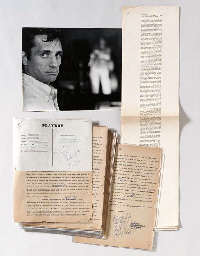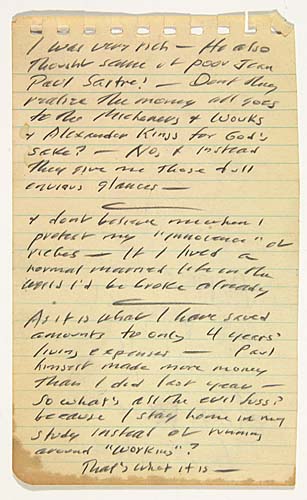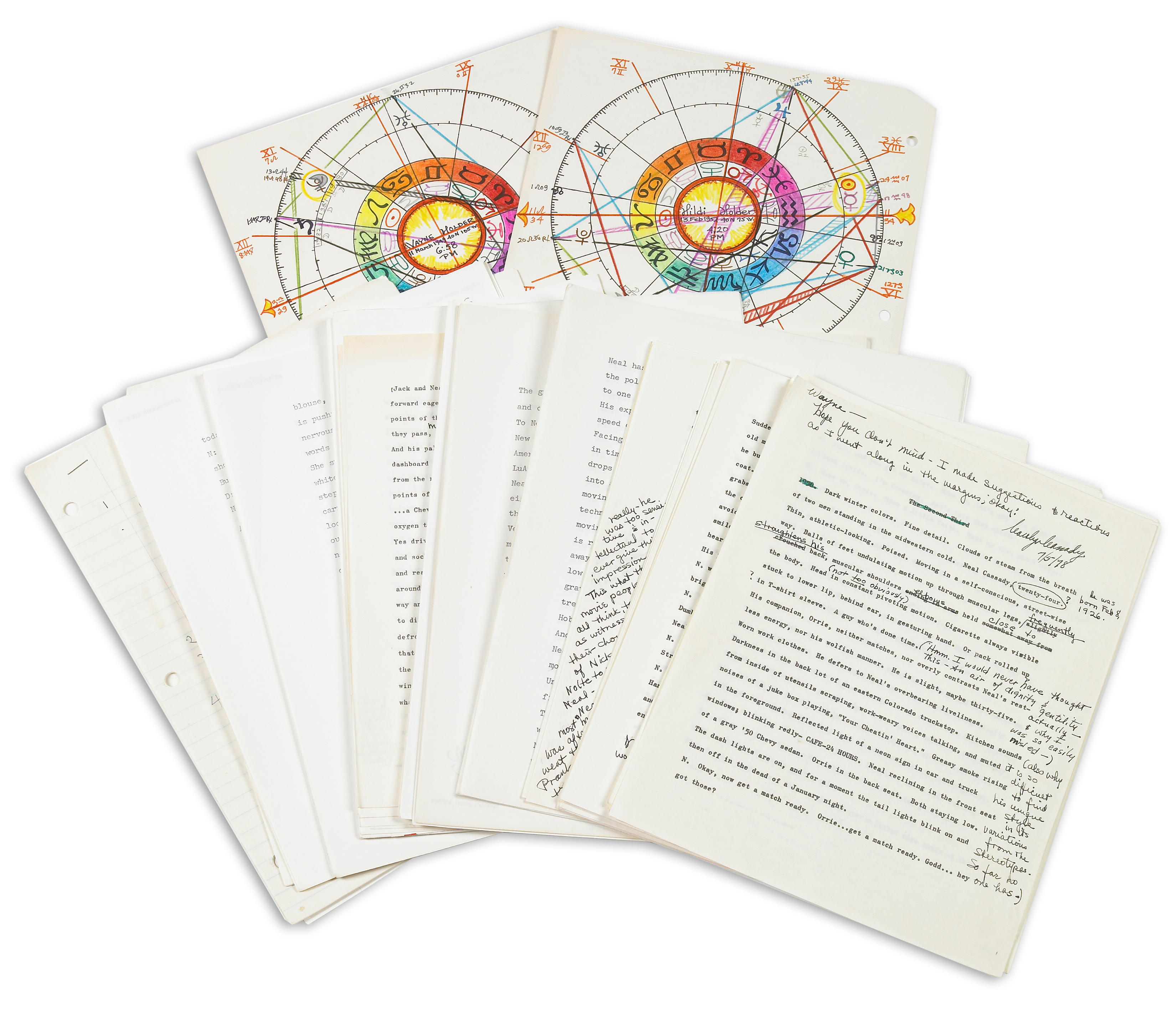Kerouac, JackAutograph manuscript of “‘Golden Jack,’” a rhapsodic account (with important connections to On the Road, and Doctor Sax) of finding God on a rainy night in New York
8 pages (227 x 152 mm), n.p. [probably New York], dated “Jan. 8, ‘49" by Kerouac at top; about 1,000 words in pencil on both sides of four leaves of lined paper removed from a spiral-bound notebook; last page slightly smudged, old folds. Housed in a black slipcase with folding cloth chemise.
"And I thought of how I thought of Neal, in his 'fine San Fran night' across dark America.”
In late December 1948 Neal Cassady drove east from San Francisco in his brand new Hudson so he and Kerouac could celebrate New Year’s Eve together. The two, along with Allen Ginsberg, Lucien Carr, John Clellon Holmes, and others of their circle, spent three weeks of mad partying in New York. On January 19, 1949, Kerouac, Cassady, and two others left the city for the West Coast, by way of New Orleans. It was Kerouac’s first cross-country trip with Cassady and it would become the story of Part Two of On the Road, which famously cast Cassady as Dean Moriarty and Kerouac as Sal Paradise. “Golden Jack,” written during this rush of parties in New York, is divided into two sections: “A Testament in the Midst of All” on the first three pages; and “An Exegesis — Why I Find God in the Rainy Night” on the remaining five.
“... I confess that I was sitting in a bebop nightclub when I [Kerouac writes in the first section] ... discovered God ... It was a rainy night in New York ... Neal and I parked the car and ran in the rain to the nightclub and sat down in front of the bandstand ... There was a saxophone lying on top of the piano beside a trumpet and a trombone. The saxophone buttons made a shadow on the wall that looked like a procession of camels — a caravan ... This scene (near the empty chair of the pianist Geo. Shearing, or as Neal said, ‘the empty chair of God’) I watched — and thought of the vast rainy night of N.Y. outside — and all our friends, and the places they were — and how all my life I had loved the ineffable, that which quivers on the horizon between heaven and earth, the sad light, the red celestials, the Pallestrinas of the sky — and I thought of how I thought of Neal, in his ‘fine San Fran night’ across the dark America (the picture on my wall, ‘night fright’) and all the night in the names Allan Eager, Dexter Gordon, bebop, Allen, Count Dracula in the Shadows, the Shadow, The Castle, Doctor Sax, me, God, America. Telephone wires, freights, hitch-hiking, Joe Martin, poor Peter, Dennison, all of it at once ... The rain, New York — All I know of New York on a rainy night, from the Shadow to Wolfe’s ships to the bebop night — the shining streets in the mist —and all of us, the Vampire bowing and saying (in Abbot & Costello movie) “You look more lovelier than ever my dear’ (after all his years of night) — My God I found— And it is in the swirling night.” This incident of Kerouac and Cassady going to hear George Shearing at Birdland while high on pot, with Neal comparing the blind pianist to God, found it’s way into On the Road (occupying a page at the end of chapter 4 in Part Two), the first version of which Jack began in the fall of 1948.
In the “Exegesis” section Kerouac refers to Dr. Sax, which he had also begun working on and which had the subtitle of The Myth of the Rainy Night: “It is because rain spiritualizes — and rain sleeps ... Because children sleep when it rains at night. And it is the sea coming back to us. (I will now write ‘Doctor Sax’ entirely different.) It doesn’t matter so much what people do in the daytime — it’s what they dream and feel and think on a rainy night. Even Doctor Sax is still on a rainy night, see ... Thinking of the night, I turn on the shortwave radio in the kitchen ... it lights up green. The green night, my friends! The green Frisco night of fogs — and Fillmore, Geary, Turk, Market, Mission, Embarcadero, Bush, Van Ness, Lombard, —Alcatraz across the lights — and Henri Cru, Dianne, Neal, Carolyn, Thompson, Ed Soucier alto-man — you see, they are all there in the green night, & immemorially. I was a boy, 16, writing diaries in Lowell, Mass., trying to describe the Lowell night, and the flood (‘humpbacked Merrimac’) ... I was a great lover at seven, I was interested in the thighs of women and girls, I peeked from the top floor and I was a little love man — But the night! The rainy foggy night! ... You must understand that I am going to lead a way to a something now. And me sleeps, too — like rain. God on January 8 did visit me, and I, imperfectly, rose — (a verb of ascension, no dissension).”
PROVENANCE:Roy R. Barkley (Christie’s New York, 19 December 1986, lot 109) — Maurice F. Neville (Sotheby's New York, 13 April 2004, lot 125)
Kerouac, JackAutograph manuscript of “‘Golden Jack,’” a rhapsodic account (with important connections to On the Road, and Doctor Sax) of finding God on a rainy night in New York
8 pages (227 x 152 mm), n.p. [probably New York], dated “Jan. 8, ‘49" by Kerouac at top; about 1,000 words in pencil on both sides of four leaves of lined paper removed from a spiral-bound notebook; last page slightly smudged, old folds. Housed in a black slipcase with folding cloth chemise.
"And I thought of how I thought of Neal, in his 'fine San Fran night' across dark America.”
In late December 1948 Neal Cassady drove east from San Francisco in his brand new Hudson so he and Kerouac could celebrate New Year’s Eve together. The two, along with Allen Ginsberg, Lucien Carr, John Clellon Holmes, and others of their circle, spent three weeks of mad partying in New York. On January 19, 1949, Kerouac, Cassady, and two others left the city for the West Coast, by way of New Orleans. It was Kerouac’s first cross-country trip with Cassady and it would become the story of Part Two of On the Road, which famously cast Cassady as Dean Moriarty and Kerouac as Sal Paradise. “Golden Jack,” written during this rush of parties in New York, is divided into two sections: “A Testament in the Midst of All” on the first three pages; and “An Exegesis — Why I Find God in the Rainy Night” on the remaining five.
“... I confess that I was sitting in a bebop nightclub when I [Kerouac writes in the first section] ... discovered God ... It was a rainy night in New York ... Neal and I parked the car and ran in the rain to the nightclub and sat down in front of the bandstand ... There was a saxophone lying on top of the piano beside a trumpet and a trombone. The saxophone buttons made a shadow on the wall that looked like a procession of camels — a caravan ... This scene (near the empty chair of the pianist Geo. Shearing, or as Neal said, ‘the empty chair of God’) I watched — and thought of the vast rainy night of N.Y. outside — and all our friends, and the places they were — and how all my life I had loved the ineffable, that which quivers on the horizon between heaven and earth, the sad light, the red celestials, the Pallestrinas of the sky — and I thought of how I thought of Neal, in his ‘fine San Fran night’ across the dark America (the picture on my wall, ‘night fright’) and all the night in the names Allan Eager, Dexter Gordon, bebop, Allen, Count Dracula in the Shadows, the Shadow, The Castle, Doctor Sax, me, God, America. Telephone wires, freights, hitch-hiking, Joe Martin, poor Peter, Dennison, all of it at once ... The rain, New York — All I know of New York on a rainy night, from the Shadow to Wolfe’s ships to the bebop night — the shining streets in the mist —and all of us, the Vampire bowing and saying (in Abbot & Costello movie) “You look more lovelier than ever my dear’ (after all his years of night) — My God I found— And it is in the swirling night.” This incident of Kerouac and Cassady going to hear George Shearing at Birdland while high on pot, with Neal comparing the blind pianist to God, found it’s way into On the Road (occupying a page at the end of chapter 4 in Part Two), the first version of which Jack began in the fall of 1948.
In the “Exegesis” section Kerouac refers to Dr. Sax, which he had also begun working on and which had the subtitle of The Myth of the Rainy Night: “It is because rain spiritualizes — and rain sleeps ... Because children sleep when it rains at night. And it is the sea coming back to us. (I will now write ‘Doctor Sax’ entirely different.) It doesn’t matter so much what people do in the daytime — it’s what they dream and feel and think on a rainy night. Even Doctor Sax is still on a rainy night, see ... Thinking of the night, I turn on the shortwave radio in the kitchen ... it lights up green. The green night, my friends! The green Frisco night of fogs — and Fillmore, Geary, Turk, Market, Mission, Embarcadero, Bush, Van Ness, Lombard, —Alcatraz across the lights — and Henri Cru, Dianne, Neal, Carolyn, Thompson, Ed Soucier alto-man — you see, they are all there in the green night, & immemorially. I was a boy, 16, writing diaries in Lowell, Mass., trying to describe the Lowell night, and the flood (‘humpbacked Merrimac’) ... I was a great lover at seven, I was interested in the thighs of women and girls, I peeked from the top floor and I was a little love man — But the night! The rainy foggy night! ... You must understand that I am going to lead a way to a something now. And me sleeps, too — like rain. God on January 8 did visit me, and I, imperfectly, rose — (a verb of ascension, no dissension).”
PROVENANCE:Roy R. Barkley (Christie’s New York, 19 December 1986, lot 109) — Maurice F. Neville (Sotheby's New York, 13 April 2004, lot 125)


.jpg)


.jpg)
.jpg)
.jpg)
.jpg)
.jpg)
.jpg)

Testen Sie LotSearch und seine Premium-Features 7 Tage - ohne Kosten!
Lassen Sie sich automatisch über neue Objekte in kommenden Auktionen benachrichtigen.
Suchauftrag anlegen